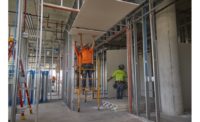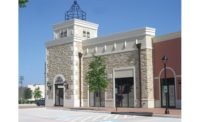
A
fire-rated glass floor systems doubles as a walking surface and light shaft to
the floors below
When thinking about construction materials for fire-rated walls, what comes to mind? Steel, concrete and masonry. Although these materials can create a physical barrier to the spread of fire, they obstruct light and can prove challenging when working to create open and collaborative spaces. An alternative solution gaining popularity within the building industry is fire-rated glass wall panels.
Tested to the same standards as solid walls-yet transparent-fire-rated glass wall panels can help building teams enhance visibility and aesthetics without compromising performance or safety. To do so, the teams must have a good working knowledge of the product. As a starting point, following are seven need-to-know answers to questions about the performance and design capabilities of fire-rated glass wall panels.

Floor-to-ceiling
fire-resistant glazing allows for exceptional views at the Discovery World
Museum
Many types of fire-rated glazing provide fire protection, meaning they can defend against the spread of flames and smoke. Fire-rated glass wall panels are one material that goes beyond that performance to also limit the transfer of radiant and conductive heat through the wall. Known as fire resistance, this added layer of defense allows the glazed panels to be suitable for use in walls or doors that must block the passage of excessive heat, hot gases or flames.
While fire-rated glass wall panel technology varies by manufacturer, the systems typically provide fire resistance in essentially the same way: Multiple layers of glass sandwich an inert material that turns opaque and foams up during a fire. The internal reaction allows the glass to remain relatively cool on the non-fire side of the wall, protecting building occupants and valuables from high heat.

Transparent
fire-rated glass wall panels help transfer light through a stairwell
Among the test standards for fire-rated glass wall panels are: ASTM E-119, Standard Methods for Fire Tests of Building Construction and Materials; NFPA 251, Standard Methods of Tests of Fire Resistance of Building Construction and Materials; and UL 263, Fire Tests of Building Construction and Materials.
To earn these designations, fire-rated glass wall panels must pass fire and hose stream tests. During the fire test, independent testing facilities treat the glass and frame as a wall assembly and place it in a large furnace. The furnace heats the glass following a standard time/temperature curve per National Fire Protection Association (NFPA) standards. To pass the test, the glass and frame must remain intact, without exceeding an average of 250 degrees Fahrenheit above ambient room temperature on the non-fire-side of the wall for its given fire-rating period. The assembly then immediately undergoes the hose stream test, where the lab douses it with water from a hose. This process evaluates the impact, erosion and cooling effects of water and exposes inadequate materials or construction.
Where can I install fire-rated glass wall panels?
Fire-rated glass wall panels generally are suitable where building codes require an assembly designated “fire resistant” to enclose a space. This can include, but is not limited to, wall and door applications requiring a 60-minute or greater fire rating such as stairwells, exit access corridors or other fire barriers dividing interior construction. Check local codes for specific requirements.
While less common, fire-rated glass wall panels can be used in exterior applications to help prevent a fire from spreading to or from other nearby buildings. This is particularly relevant in areas with high building density and narrow setbacks from lot lines.
Am I limited to vertical applications?
No. Some manufacturers are now offering fire-rated glass floor systems for interior and exterior applications that require a code-approved fire barrier between floors. These assemblies may incorporate fire-rated glass wall panels to provide adequate fire resistance.
Common interior applications for fire-rated glass floor systems include lobby floors, atriums, corridors near exits and other public egress areas at risk for fire progression. Exterior applications include skylights as well as roofs that are expected to support foot traffic. Since horizontal fire-rated applications must meet additional requirements, such as load standards and slip resistance, always check local codes.
Can I install fire-rated glass wall panels where they are susceptible to impact?
Yes. Fire-rated glass wall panels are available with up to Category II (CPSC 16CFR 1201) impact-safety ratings. This is the highest standard impact-safety rating available, indicating that the glass can safely withstand an impact similar to that of full-grown, fast moving adult. As such, transparent wall panels are ideal for use in high-traffic areas, including schools, gymnasiums and hospitals.
Fire-rated glass wall panels are also available with Level III bullet resistance ratings for banks, police stations and other at-risk buildings.

The
Art Institute of Chicago Modern Wing relies on transparent fire-rated wall
panels and custom fire-rated aluminum frames to improve internal visibility
Since transparent fire-rated glass walls provide fire resistance, they are not restricted to 25 percent of the wall-as may be the case with fire-protective glazing. This flexibility makes them suitable for use in floor-to-ceiling and wall-to-wall designs or in full lite (weight) glass doors. For example, project teams can incorporate fire-rated glass wall panels throughout school corridors where illumination and views to the outside can improve working environments for children (see “Art Institute of Chicago: Meeting Life Safety Codes While Achieving a Design Vision”). Or, they can place them in stairwells and elevators to help create safer walkways and brighten hard-to-light interior cores.
To create large glazed spans, building teams can install sequences of fire-rated glass wall panels or fire-resistive-rated curtain walls. Individual fire-rated wall panels are currently available as large as 5 x 8 feet per lite.
What kind of frame should accompany fire-rated glass wall panels?
Mismatched ratings for fire-rated glass and framing can jeopardize safety. As a result, the framing surrounding fire-rated glass wall panels must carry the same fire rating as the panels and be classified as fire resistant. For instance, if a full lite, glazed door utilizes 90-minute, fire-resistive-rated wall panels, the frame and its component parts also should carry a 90-minute fire rating and provide protection against heat transfer.
Today, there are many fire-resistant-rated framing options from which to select. Manufacturing advances have led to thinner, fire-rated frames that can be custom painted or powder coated to match virtually any color scheme. Framing options include aluminum and steel constructions. A recent innovation in framing makes it possible for fire-rated applications to be free of front framing members as well. Historically, a structurally silicone glazed (SSG) type of system wasn’t available for fire rated areas, yet advances in design and construction now make this innovation a reality.
Moving Forward
As technology evolves, so do the uses and applications for fire-rated glass wall panels. To stay ahead of the curve, ask your manufacturer or supplier for the latest enhancements, along with specific questions regarding a given product’s make-up, performance and installation.
Art Institute of Chicago: Meeting Life Safety Codes While Achieving a Design Vision
When the Art Institute of Chicago commissioned the design of a new modern wing, they desired understated architecture where elegant lines and spacious galleries maintained art as the focal point. Just as important to the museum was integrating the modern wing with the original buildings as well as the vital city center, Chicago skyline, and neighboring Millennium Park.
One challenge the architects faced was how to maintain clear lines of sight from historic Michigan Avenue through the space to the fresh landscape of the Millennium Park Courtyard. The interior walls for the classrooms and boardrooms needed to be transparent yet also meet fire and life safety codes.
The architects met this need by combining transparent wall panels with a custom, narrow-profile fire-rated aluminum framing system, tested as a one-hour fire-rated wall assembly and listed by Underwriters Laboratories (UL). The extensive amounts of transparent glass helped improve sightlines, create refreshing views from the inside out and improve internal visibility. As a fire-rated wall assembly it blocks the transfer of radiant heat, providing critical protection for the museum’s visitors and irreplaceable valuables from the intense heat of a structural fire.




Report Abusive Comment